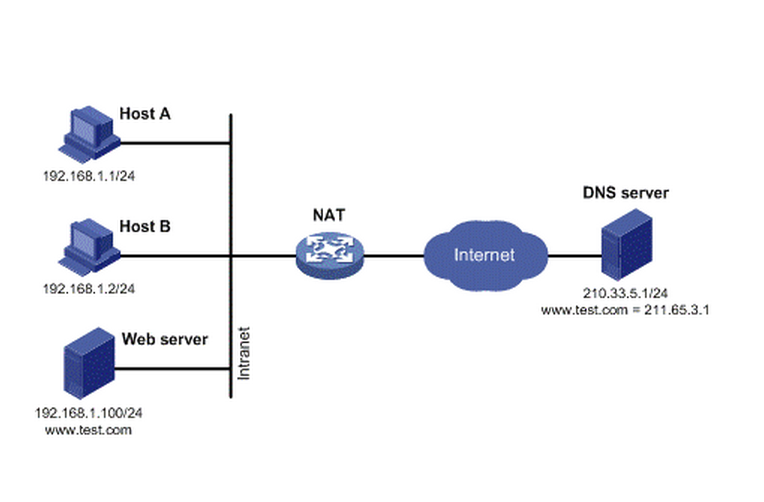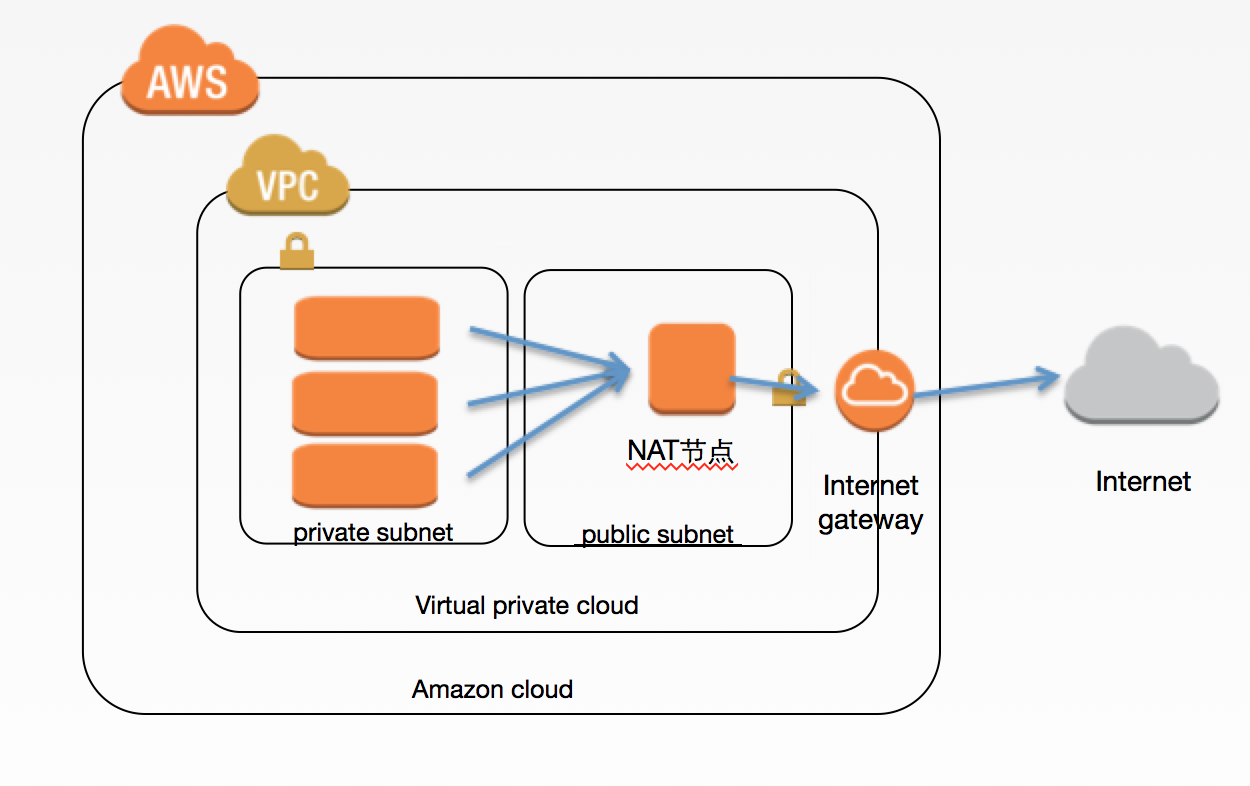在AWS中创建NAT节点
NAT, Network Address Translation,即网络地址转换。当内部网络的主机想要访问外网,但是又不想直接暴露给公网,可以通过NAT节点来访问外网。这样做有两个好处,第一是内网的主机无需拥有公网IP就可访问网络(NAT节点需要公网IP),节约了公网IP;第二是内网的主机由于没有公网IP,所以公网的电脑无法访问到它,这样就可以隐藏自己。一个很经典的示例是假如你有一台数据库服务器放置在内网中,为在同一个内网中的web服务器提供数据服务,为了安全性考虑你不会把它直接暴露在公网中。但是数据库服务器有时候自己是需要访问公网的,比如需要升级数据库服务器中的某些软件等。采用NAT方案可以很好的解决这个问题。
下图是NAT节点的功能示意图。

一些路由器或者装有特定软件的主机都可以作为NAT节点。在AWS中如果你想创建一个NAT节点的话那是非常的方便,因为AWS直接提供了预装了NAT软件的AMI,你只需直接使用该AMI在你的公共子网中实例化一台机器,并进行相应的配置即可。
下面的图展示了在AWS中的一个经典的VPC架构。该VPC里面建立了两个子网,一个是公共子网,通过Intenet Geteway和公网连接;一个是私有子网,无法直接访问公网。然后在公共子网中建立了一个EC2机器,使用的是AWS提供的具有NAT功能的AMI,并为它分配了一个弹性IP,这样该EC2就是一个NAT节点。在私有子网的所有机器都具有了通过该NAT节点访问外网的能力。

为了创建这样一套网络及机器,最简便的方式当然是使用AWS提供的CloudFormation了。如果不了解CloudFormation,可以看我以前写过的一篇文章 《亚马逊云服务之CloudFormation》。下面展示的是创建该整个VPC的CloudFormation脚本。
|
|
你可以通过AWS提供的图形化界面AWS Management Console来使用该CloudFormation脚本,也可以通过AWS CLI来使用。使用以上的CloudFormation脚本创建的VPC可以一键创建你AWS中的基础网络架构。从此再也不用为配置网络发愁了。
在AWS中创建NAT节点的更多相关文章
- linux中创建gpio节点
转自:http://blog.chinaunix.net/uid-29165999-id-4296162.html #define GPIO_MAJOR 230 // major device NO. ...
- Labview中创建属性节点和调用节点的用法
创建属性节点 个人感觉有点像C中的指针 创建调用节点
- javascript中创建新节点的方法 标签: javascript 2016-12-25 11:38 55人阅读 评论(0)
一. var newnode=document.createElement("i"); var newnodeText=document.createTextNode(" ...
- platform型设备在/dev目录下自动创建设备节点的分析【转】
转自:http://blog.csdn.net/rockrockwu/article/details/7357648 系统启动过程中platform设备.驱动注册完毕,为什么在/dev目录下就自动创建 ...
- js中创建html标签、加入select下默认的option的value和text、删除select元素节点下全部的OPTION节点
<pre name="code" class="java"> jsp 中的下拉框标签: <s:select name="sjx&qu ...
- jQuery中的查找节点、创建节点、插入节点、删除节点、替换节点、复制节点操作方法
jQuery操作节点我们可以分六点来讲,查找节点.创建节点.插入节点.删除节点.替换节点.复制节点. 一.查找节点 text() - 设置或返回所选元素的文本内容 ,html() - 设置或返回所 ...
- js动态创建style节点(js文件中添加css)
ie6 不能 document.createElement('style') 然后append到head标签里.所以就找到这样个好文章 --------------------- 有很多提供动态创建 ...
- 在AWS中部署OpenShift平台
OpenShift是RedHat出品的PAAS平台.OpenShift做为PAAS平台最大的特点是它是完全容器化的PAAS平台,底层封装了Docker和Kubernetes,上层暴露了对开发者友好的接 ...
- aws中的路由表
参考官方文档: 由表中包含一系列被称为路由的规则,可用于判断网络流量的导向目的地. 在您的 VPC 中的每个子网必须与一个路由表关联:路由表控制子网的路由.一个子网一次只能与一个路由表关联,但您可以将 ...
随机推荐
- javascript父级鼠标移入移出事件中的子集影响父级的处理方法
一.我们先分析其产生的原因: 1.当鼠标从父级移入子集时触发了父级的两个事件:a.父级的mouseout事件(父级离开到子集):b.由于事件冒泡影响,又触发了父级的mouseover事件(父级移入父级 ...
- TColor 与 RGB 的转换函数
function RGB2TColor(const R, G, B: Byte): Integer;begin // convert hexa-decimal values to RGB Resu ...
- map阶段动态获取CombineTextInputFormat各输入文件路径
老mr程序中map中conf的map.input.file参数只能获取获取CombineTextInputFormat的第一个输入文件,而新版mr程序则连第一个输入文件也无法获取,这是因为create ...
- css js 的引入方式和书写位置
css 的引入方式 1.行内样式 <div id="div1" style="width:100px; height:100px; background:red&q ...
- 51nod 1138 连续整数的和(数学公式)
1138 连续整数的和 #include <iostream> #include <cmath> #include <cstdio> using namespace ...
- Hibernate-list()与iterate()方法的区别
对于list方法而言,实际上Hibernate是通过一条Select SQL获取所有的记录.并将其读出,填入到POJO中返回.而iterate 方法,则是首先通过一条Select SQL 获取所有符合 ...
- shell数组操作
1.数组定义,shell使用一对括号表示数组,数组元素间用"空格"分隔 # 空数组arr1 arr1=() # 数组arr2,成员分别是1, 2, 3, 4, 5, 6 arr2= ...
- 简单的css js控制table隔行变色
(1)用expression 鼠标滑过变色: <style type="text/css"><!-- table { background-color:#0000 ...
- 将 project.json 项目转换为 Visual Studio 2015 解决方案
var appInsights=window.appInsights||function(config){ function r(config){t[config]=function(){var i= ...
- js组件之间的通信
应用场景: 1.在刷微博的时候,滑到某个头像上,会出现一张usercard(用户名片), 微博列表区有这个usercard, 推荐列表也有这个usercard,评论区也有. 2.在网上购物时,购物车安 ...
